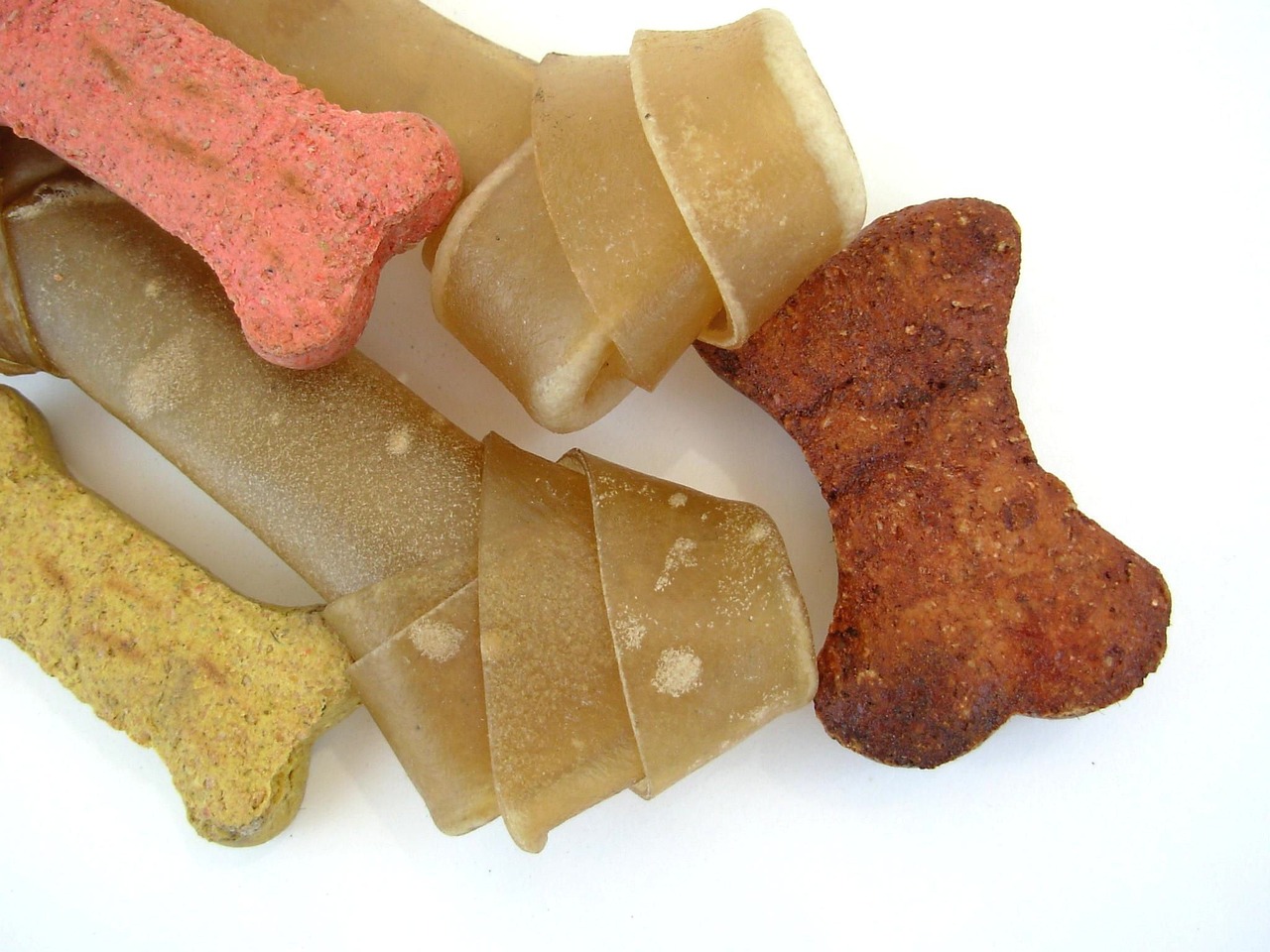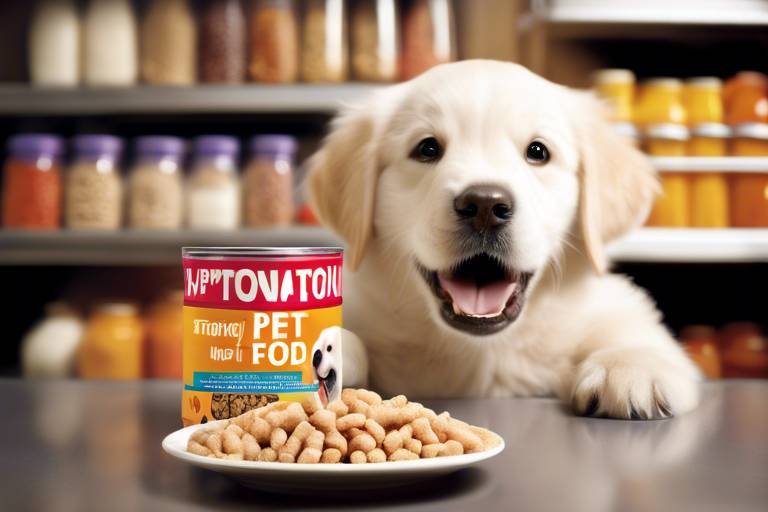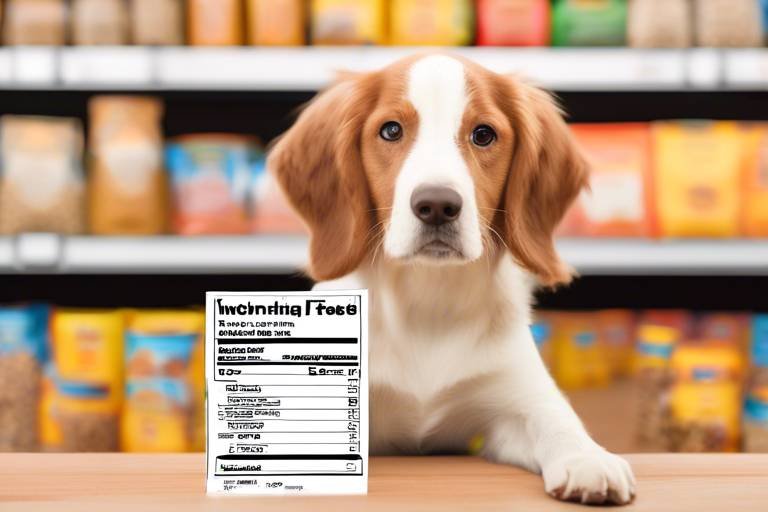How to Choose the Best Treats for Training
When it comes to training your furry friend, the right treats can make all the difference. Imagine trying to motivate someone without offering them a reward—sounds tough, right? Well, your dog is no different! Choosing the best treats for training involves understanding your dog's unique preferences, the types of treats available, and ensuring that the ingredients are not just tasty but also healthy. This article explores the essential factors to consider when selecting treats for dog training, ensuring they are effective, healthy, and appealing to your canine companion.
Recognizing what flavors and textures your dog enjoys can significantly enhance training effectiveness. Just like humans, dogs have their own likes and dislikes. Some might go crazy for peanut butter, while others prefer chicken or liver. Tailoring treats to their favorites will keep them motivated and engaged during training sessions. To find out what your dog loves, try offering a variety of treats and observe their reactions. You might be surprised at what they gravitate towards!
There are various types of treats available, including soft, crunchy, and freeze-dried options. Each type serves different training purposes and can be chosen based on your dog's specific needs. For example, soft treats are often easier for dogs to chew and swallow quickly, making them ideal for fast-paced training. On the other hand, crunchy treats can be more satisfying for some dogs and can even aid in dental health. Understanding these differences will help you select the best options for your training sessions.
Soft treats are often more enticing for dogs, making them ideal for training. Their ease of chewing allows for quick rewards, helping maintain focus during sessions. Picture this: you're in the middle of teaching your dog a new trick, and they nail it! You want to reward them immediately to reinforce that good behavior. Soft treats allow you to do just that without the fuss of waiting for them to chew through something harder.
Soft treats are typically higher in moisture and flavor, making them irresistible to many dogs. They can also be broken into smaller pieces for low-calorie rewards. This is especially important if you're training multiple times a day. You want to reward your dog without overloading them with calories. Think of soft treats as the ultimate training tool—quick, effective, and enjoyable!
When selecting soft treats, look for high-quality ingredients and avoid artificial additives. Opt for treats that are specifically formulated for training purposes. Remember, just because a treat is soft doesn't mean it's good for your dog. Always check the label for natural ingredients and steer clear of anything that sounds like it belongs in a chemistry lab.
Crunchy treats can be beneficial for dental health and provide a satisfying texture. However, they may not be as effective for quick rewards during training. Imagine trying to get your dog to focus while they're chomping away on a crunchy treat—it can take a while! That said, incorporating crunchy treats into your training regime can still be a fun way to mix things up. Just be mindful of when you use them.
The quality of ingredients in training treats is crucial for your dog's health. Prioritizing natural and nutritious components ensures that treats contribute positively to their diet. Just like we wouldn't want to eat junk food all the time, our dogs deserve better too. When you choose high-quality treats, you're not just rewarding your dog; you're also supporting their overall well-being.
Choosing treats with natural ingredients can help avoid potential allergens and health issues. Understanding ingredient labels is essential for making informed choices. Look for treats that list real meat, vegetables, or grains as their primary ingredients. If you see a long list of unpronounceable additives, it's best to put that treat back on the shelf.
Monitoring the caloric content of treats is important to prevent overfeeding. Opt for low-calorie options to maintain a healthy weight while still rewarding your dog effectively. After all, a happy dog is a healthy dog! You can also consider using part of your dog’s regular meal as a training treat—double duty at its finest!
- What are the best treats for training a puppy? Soft, small-sized treats are usually the best as they are easy for puppies to chew and digest.
- Can I use my dog's regular kibble as treats? Absolutely! Using kibble can be a great way to reward your dog without adding extra calories.
- How many treats should I give during training? Keep it moderate; treats should make up no more than 10% of your dog's daily caloric intake.
- Are homemade treats a good option? Yes! Homemade treats can be a healthy alternative, just ensure they are made with dog-safe ingredients.

Understanding Your Dog's Preferences
When it comes to dog training, one of the most essential factors that can make or break your success is understanding your dog's preferences. Just like humans, dogs have their own unique tastes and likes, which can greatly influence their motivation during training sessions. Imagine trying to motivate a child with a food they dislike—it's just not going to work! Similarly, if your dog isn't excited about the treats you're using, you might find their enthusiasm waning.
So, how do you figure out what makes your furry friend wag their tail with joy? Start by observing their reactions to different flavors and textures. For instance, does your dog perk up at the smell of peanut butter, or do they go crazy for chicken? You might be surprised to discover that some dogs have a preference for certain textures as well. While some may prefer soft, chewy treats, others might enjoy the satisfying crunch of a biscuit. Paying attention to these details can help you tailor your training treats to suit their individual tastes.
To make the most of your training sessions, consider conducting a little taste test. Offer your dog a variety of treats—soft, crunchy, and even freeze-dried options—and see which ones they gravitate towards. This not only makes training more enjoyable for your dog but also creates a stronger bond between you two as you discover what makes them tick. Remember, the goal is to keep your dog engaged and motivated, and knowing their preferences is a big step in that direction.
Moreover, it's important to note that dogs can have mood swings just like us! A treat that was once their favorite might not hold the same appeal on another day. This is why having a variety of treats on hand can be beneficial. You can rotate between different types to keep things fresh and exciting. Think of it as a buffet of rewards that keeps your dog eager and ready to learn!
In summary, understanding your dog's preferences is key to selecting the right training treats. By observing their reactions and conducting some fun experiments, you can ensure that your training sessions are not only effective but also a delightful experience for your canine companion. After all, a happy dog is a motivated dog, and that’s what every trainer hopes for!

Types of Training Treats
When it comes to training your furry friend, the type of treats you choose can make a world of difference. Not all treats are created equal, and understanding the various types available can help you pick the best ones for your dog's training needs. Generally, training treats fall into three main categories: soft treats, crunchy treats, and freeze-dried options. Each of these types serves a unique purpose and can be tailored to fit your dog's preferences and training style.
Soft treats are often the go-to choice for many dog trainers. Their appealing texture and rich flavor make them irresistible to most dogs. Imagine trying to motivate your dog to learn a new trick with a hard, crunchy treat—it's like trying to get a child to focus on math homework while holding a soggy sandwich! The ease of chewing soft treats allows for quick rewards, keeping your dog engaged and motivated throughout the training session. Plus, they can be broken into smaller pieces, making them perfect for low-calorie rewards.
On the other hand, crunchy treats have their own set of advantages. Not only do they provide a satisfying crunch that many dogs love, but they can also contribute to your dog's dental health by helping to remove plaque and tartar. However, it's important to note that crunchy treats may not be as effective for quick rewards. If you're in the middle of a training session and your dog is waiting eagerly for a treat, the time it takes them to chew a crunchy snack might break their focus. Therefore, you might want to reserve these for times when you're not actively training.
Then we have freeze-dried treats, which are becoming increasingly popular among dog owners. These treats maintain much of their nutritional value and flavor due to the freeze-drying process, making them an excellent option for training. They are lightweight, easy to carry, and can be crumbled into smaller pieces if needed. However, they might be more expensive than other types, so it's worth considering your budget when choosing training treats.
Ultimately, the best type of training treat for your dog will depend on their individual preferences and the specific training goals you have in mind. Whether you opt for soft, crunchy, or freeze-dried treats, the key is to keep your dog motivated and excited about learning. A mix of different types can also be beneficial, providing variety and keeping your training sessions fresh and engaging. Remember, the right treat can turn a simple training session into a fun and rewarding experience for both you and your furry companion!
Q: How many treats should I give my dog during training?
A: It's important to monitor the number of treats you give your dog to prevent overfeeding. A good rule of thumb is to limit treats to no more than 10% of your dog's daily caloric intake.
Q: Can I use my dog's regular food as training treats?
A: Absolutely! Using your dog's regular kibble can be a great way to reward them during training, especially if they are motivated by their food. Just be sure to adjust their overall food intake accordingly to maintain a healthy weight.
Q: Are homemade treats a good option for training?
A: Yes, homemade treats can be a fantastic option! They allow you to control the ingredients and ensure they are healthy. Just make sure they are small, soft, and easy for your dog to chew quickly.
Soft Treats
When it comes to dog training, are often the unsung heroes. These delightful morsels are not just tasty; they can significantly enhance your dog's focus and enthusiasm during training sessions. Imagine a scenario where your furry friend is eagerly awaiting a reward after performing a trick. The moment you pull out a soft treat, their eyes light up with excitement! This is because soft treats are typically more enticing than their crunchy counterparts, thanks to their rich flavors and inviting aromas.
One of the standout features of soft treats is their ease of chewing. Unlike crunchy treats that require more effort to break down, soft treats allow for quick consumption, which means your dog can get back to focusing on the next command. This immediacy is crucial during training, as it helps maintain momentum and keeps your dog engaged. Think of it like a quick snack during a study session; it boosts motivation and keeps you on track!
Additionally, soft treats are often higher in moisture, which contributes to their palatability. Many dogs find these treats irresistible, making them perfect for rewarding good behavior. You can also break them into smaller pieces, providing low-calorie rewards without compromising on flavor. This is especially beneficial if you're working on multiple commands or tricks in one session. Imagine training your dog to sit, stay, and roll over, all while keeping their caloric intake in check!
However, not all soft treats are created equal. When selecting the right ones for your dog, it's essential to pay attention to the ingredients. Look for treats that are made with high-quality, natural ingredients and avoid those with artificial additives. A treat that is specifically formulated for training will not only be more effective but also healthier for your furry friend. You want to ensure that you are rewarding them with something that adds value to their diet, rather than empty calories.
In summary, soft treats are a fantastic tool in your training arsenal. They are effective, engaging, and enjoyable for your dog. So the next time you're gearing up for a training session, consider reaching for those soft, delectable treats that will have your pup eagerly working for their rewards!
Benefits of Soft Treats
When it comes to training your dog, soft treats are often the unsung heroes. Their texture and moisture content not only make them incredibly appealing to our furry friends, but they also provide a host of benefits that can enhance the overall training experience. Imagine trying to coax your dog into performing a trick with a hard, crunchy treat; it just doesn't have the same allure, does it? Soft treats are like the chocolate chip cookies of the dog world—irresistible and delightful!
One of the primary advantages of soft treats is their ease of consumption. Dogs can chew and swallow them quickly, which is crucial during training sessions where timing is everything. You want to reward your pup immediately after they perform a command, and soft treats allow for that instant gratification. This quick reward system helps reinforce positive behavior, keeping your dog motivated and eager to learn.
Moreover, soft treats are often loaded with flavor, thanks to their higher moisture content. This makes them not only delicious but also highly enticing for dogs. Many dogs find it difficult to resist a treat that smells and tastes amazing, which can be a game-changer when you’re trying to teach new commands or tricks. Think about it: would you rather have a bland cracker or a warm, gooey cookie? Your dog feels the same way!
Another benefit is the ability to break soft treats into smaller pieces. This is particularly useful for training sessions where you want to reward your dog frequently without overloading them on calories. By offering smaller pieces, you can maintain a consistent reward system while ensuring your dog stays within their dietary limits. It’s a win-win situation!
However, not all soft treats are created equal. When selecting the right ones, it’s essential to choose those made from high-quality ingredients that are specifically formulated for training. Look for treats that are free from artificial additives and preservatives, as these can be detrimental to your dog's health in the long run. Always check the ingredient list to ensure you're providing the best for your furry companion.
In summary, soft treats are a fantastic option for dog training due to their enticing flavor, quick consumption, and flexibility in portioning. They help create a positive reinforcement loop that encourages your dog to learn and grow while making the training experience enjoyable for both you and your pup. So, the next time you're gearing up for a training session, consider reaching for those soft, delicious treats—they might just be the key to unlocking your dog's full potential!
- What are the best ingredients to look for in soft treats? Look for natural ingredients such as real meat, fruits, and vegetables, avoiding artificial additives.
- Can I use soft treats for all types of training? Yes, soft treats are versatile and can be used for various training activities, from basic commands to agility training.
- How many treats should I give my dog during training? It depends on your dog's size and dietary needs, but aim for small portions to avoid overfeeding.
- Are soft treats suitable for dogs with allergies? Always check the ingredient list and consult your vet if your dog has known allergies before introducing new treats.
Choosing the Right Soft Treats
When it comes to selecting the perfect soft treats for your furry friend, there are a few key factors that you should keep in mind to ensure you're making the best choice. First and foremost, ingredient quality is paramount. Look for treats made from real meat, vegetables, and whole grains. Avoid those that contain artificial preservatives, colors, or flavors, as these can be harmful to your dog's health. Instead, opt for treats that boast a short ingredient list, which often indicates a more natural product.
Another essential aspect to consider is the size and texture of the treats. Soft treats should be easy to chew and swallow, especially during training sessions when you want your dog to focus on learning rather than struggling with their reward. Ideally, the treats should be small enough to be consumed quickly, allowing for rapid reinforcement of good behavior. This is crucial because the faster your dog receives a reward, the more likely they are to associate it with the desired action.
Don't forget to check the nutritional value of the treats as well. Many soft treats are formulated to be lower in calories, which is beneficial for maintaining your dog's weight. This is particularly important if you're using treats frequently during training. A good rule of thumb is to choose treats that contain less than 10 calories each. This way, you can reward your dog without worrying about overfeeding.
Another factor to consider is your dog's specific dietary needs. For instance, if your dog has food allergies or sensitivities, it's crucial to choose treats that are free from those allergens. Many brands now offer specialized soft treats designed for dogs with specific dietary restrictions, such as grain-free or limited-ingredient options. Always read the packaging carefully and consult your veterinarian if you're unsure about what is safe for your pet.
Lastly, consider the flavor profiles that your dog enjoys. Just like humans, dogs have their own unique tastes. Some may prefer chicken or beef, while others might go crazy for peanut butter or sweet potato. Trying out a few different flavors can help you discover what makes your dog wag their tail the most. You might even find that your dog has a favorite flavor that makes training sessions even more exciting!
In summary, when choosing the right soft treats for your dog, focus on high-quality ingredients, appropriate size and texture, nutritional value, dietary needs, and flavor preferences. By taking these factors into account, you'll not only enhance your training sessions but also contribute positively to your dog's overall health and happiness.
- What are the best ingredients to look for in dog treats? High-quality protein sources like real meat, whole grains, and vegetables are ideal.
- How often should I use treats during training? Use treats frequently but in moderation to avoid overfeeding.
- Can I make my own soft treats at home? Absolutely! Homemade treats can be a great way to ensure quality ingredients.
- What if my dog has allergies? Always choose treats specifically formulated for your dog's dietary restrictions.
Crunchy Treats
Crunchy treats are a popular choice among dog owners for several reasons. These treats not only satisfy your dog's natural chewing instinct but also offer some dental health benefits. The act of chewing can help reduce plaque and tartar buildup, which is essential for maintaining a healthy mouth. However, while crunchy treats can be beneficial, they may not always be the best option for training sessions where speed and quick rewards are crucial.
When considering crunchy treats, it’s important to think about the context in which you’ll be using them. For instance, if you’re in the middle of a training session, you might find that your dog takes longer to chew through a crunchy treat, which can interrupt the flow of training. In contrast, soft treats can be consumed quickly, allowing for immediate reinforcement of good behavior. This doesn’t mean you should entirely rule out crunchy treats; they can still be a rewarding option during playtime or as an occasional snack.
Here are some key points to consider when incorporating crunchy treats into your dog’s diet:
- Texture and Flavor: Dogs often enjoy the satisfying crunch, but it’s essential to choose flavors that appeal to your furry friend. Experiment with different options to see which ones they prefer.
- Portion Control: Since crunchy treats can be higher in calories, be mindful of the portion sizes. You don’t want to accidentally overfeed your dog, especially if you’re using them frequently during training.
- Ingredient Quality: Just like soft treats, the quality of ingredients in crunchy treats matters. Look for options made with natural ingredients and avoid those with artificial preservatives or fillers.
In summary, crunchy treats can be a delightful addition to your dog’s treat repertoire, offering both enjoyment and health benefits. They should be used thoughtfully, especially during training sessions where quick rewards are needed. By understanding your dog's preferences and the role of crunchy treats, you can create a balanced and enjoyable training experience.
Q: Can I use crunchy treats for training?
A: While crunchy treats can be used for training, they may not be as effective as soft treats since dogs might take longer to chew them. It's best to reserve crunchy treats for playtime or as occasional rewards.
Q: Are all crunchy treats good for my dog's teeth?
A: Not all crunchy treats are created equal. Look for those specifically designed to promote dental health and check for quality ingredients to ensure they contribute positively to your dog's diet.
Q: How can I monitor the caloric intake of crunchy treats?
A: Always check the packaging for caloric information and adjust your dog's regular meals accordingly to prevent overfeeding. Consider using low-calorie options for training purposes.

Ingredient Quality
When it comes to choosing the best treats for training your dog, is paramount. You wouldn’t want to fuel your furry friend with just anything, right? The treats you select should not only be tasty but also nutritious. Think of it like preparing a meal for a child; you want to ensure every bite is packed with goodness. High-quality ingredients can significantly impact your dog's overall health and well-being, making it essential to scrutinize what goes into those little morsels.
One of the first things to consider is the difference between natural and artificial ingredients. Natural ingredients are derived from real food sources, while artificial ones are often synthetic and can contain harmful additives. For instance, when you read an ingredient label, you might come across terms like "by-products" or "fillers." These are generally a red flag. Instead, look for treats that list whole foods, such as chicken, beef, or sweet potatoes, as their primary ingredients. This not only ensures that your dog is getting the nutrients they need but also minimizes the risk of allergies and digestive issues.
Here’s a quick comparison of natural versus artificial ingredients:
| Aspect | Natural Ingredients | Artificial Ingredients |
|---|---|---|
| Nutritional Value | High | Low |
| Allergen Risk | Lower | Higher |
| Flavor | More appealing | Less appealing |
| Preservatives | Minimal | Often included |
Another critical factor is the caloric content of the treats. Just like humans, dogs can easily gain weight if they consume too many high-calorie snacks. It’s crucial to strike a balance between rewarding your dog and maintaining their health. Look for treats that are specifically designed for training, as these tend to be lower in calories yet still satisfying. By choosing lower-calorie options, you can give your dog the rewards they love without the guilt of overfeeding.
In summary, the quality of ingredients in dog training treats is not just an afterthought; it’s a fundamental aspect that can influence your dog’s health and training success. Always opt for treats made with natural ingredients, check the caloric content, and avoid anything that sounds suspicious on the label. Your dog deserves the best, and paying attention to ingredient quality ensures they get the nutrition they need while enjoying their training sessions.
- What should I look for in training treats? Look for high-quality, natural ingredients, low-calorie options, and treats that are easy to chew.
- Can I use regular dog food as training treats? While it’s possible, specialized training treats are often more enticing and easier to manage during sessions.
- How many treats can I give my dog during training? It's best to limit treats to no more than 10% of your dog's daily caloric intake to maintain a healthy weight.
- Are there any ingredients I should avoid? Yes, avoid treats with artificial additives, by-products, and fillers. Always check ingredient labels carefully.
Natural vs. Artificial Ingredients
When it comes to choosing the best treats for training your dog, one of the most critical decisions you'll face is whether to select natural or artificial ingredients. This choice can significantly influence not only your dog's health but also their enthusiasm during training sessions. Natural ingredients, often sourced from whole foods, provide a plethora of benefits, including fewer allergens and a lower risk of adverse reactions. On the other hand, artificial ingredients may offer convenience and longer shelf life, but they often come with a host of potential downsides.
Natural ingredients can include a variety of wholesome components such as real meats, fruits, and vegetables. These treats are generally more nutritious and can support your dog's overall well-being. For instance, ingredients like chicken, sweet potatoes, and blueberries not only taste great but also provide essential vitamins and minerals. In contrast, many artificial treats are packed with synthetic flavors, colors, and preservatives that can lead to health issues over time. Additionally, some dogs may develop sensitivities or allergies to these artificial additives, which can manifest in various ways, from digestive troubles to skin irritations.
It's essential to become a savvy label reader when selecting treats. Look for products that highlight their use of natural ingredients and avoid those with long lists of unrecognizable chemicals. The following table summarizes some key differences between natural and artificial ingredients:
| Aspect | Natural Ingredients | Artificial Ingredients |
|---|---|---|
| Nutritional Value | High, contains vitamins and minerals | Often low, lacks essential nutrients |
| Health Risks | Lower risk of allergies and sensitivities | Higher risk of allergies and health issues |
| Flavor | Rich and appealing to dogs | May taste artificial or overly sweet |
| Shelf Life | Shorter, requires proper storage | Longer, due to preservatives |
Ultimately, while both types of ingredients have their pros and cons, opting for treats made with natural ingredients is often the best choice for your furry friend. Not only will they enjoy the taste more, but you’ll also be contributing positively to their health. After all, a happy dog is a well-trained dog, and what better way to keep them happy than with wholesome, tasty treats?
- What are the benefits of using natural ingredients in dog treats? Natural ingredients provide essential nutrients, lower the risk of allergies, and are generally more appealing to dogs.
- Can artificial ingredients harm my dog? While not all artificial ingredients are harmful, some can lead to allergies and other health issues over time.
- How can I tell if a treat is made with natural ingredients? Always read the label! Look for recognizable ingredients and avoid those with long lists of artificial additives.
- Are there any specific ingredients I should avoid? Yes, avoid treats with artificial colors, flavors, and preservatives, as well as common allergens like wheat or corn if your dog has sensitivities.
Caloric Content
When it comes to dog training, is a critical factor that often gets overlooked. Just like us, dogs can pack on the pounds if they consume more calories than they burn. This is particularly important during training sessions, where treats are frequently used as rewards. If you're not careful, those tiny morsels can add up quickly, leading to an overweight pup who may struggle with health issues down the line.
Imagine this: you're in the middle of an exciting training session, and your dog is performing brilliantly. You reach for the treat bag, but wait! Do you know how many calories are in those treats? If you're not keeping track, you might be unintentionally sabotaging your dog's health. It's essential to choose low-calorie options that still pack a punch in terms of flavor and enjoyment. This way, you can reward your furry friend without the guilt of overfeeding.
To help you navigate the world of dog treats, consider the following factors when evaluating caloric content:
- Serving Size: Always check the serving size listed on the packaging. Sometimes, what seems like a small treat can actually contain a surprising number of calories.
- Frequency of Use: If you're training daily, you may want to opt for treats with fewer calories to avoid exceeding your dog's daily caloric intake.
- Balance with Meals: Factor in the calories from treats when planning your dog's meals. This ensures they are still receiving a balanced diet without going overboard.
To give you a clearer picture, here's a simple table comparing the caloric content of different types of training treats:
| Treat Type | Average Calories per Treat | Notes |
|---|---|---|
| Soft Treats | 3-10 | Higher moisture content, easy to chew. |
| Crunchy Treats | 5-15 | Good for dental health, but may take longer to chew. |
| Freeze-Dried Treats | 8-12 | Lightweight and flavorful, but check for added ingredients. |
By being mindful of caloric content, you can ensure that your training sessions are both enjoyable and healthy for your dog. Remember, the goal is to motivate and reward your pup without compromising their well-being. So, as you embark on your training journey, keep those calories in check, and watch your dog thrive!
Q: How many treats can I give my dog during training?
A: It varies by dog size and activity level, but a good rule of thumb is to limit treats to no more than 10% of their daily caloric intake.
Q: Are homemade treats better than store-bought ones?
A: Homemade treats can be healthier since you control the ingredients, but ensure they are balanced and not overly caloric.
Q: What should I do if my dog refuses to eat the treats?
A: Experiment with different flavors and textures. Sometimes, a simple change can reignite their interest!
Frequently Asked Questions
- What types of treats are best for training my dog?
When it comes to training treats, soft treats are often the most effective. They are easy to chew and can be quickly consumed, allowing your dog to stay focused on training. Crispy treats can also be used, but they may not be as quick to reward as soft ones. Ultimately, the best choice depends on your dog's preferences and training goals.
- How can I determine my dog's favorite flavors?
The easiest way to find out what your dog likes is to experiment with different flavors and textures. Try offering a variety of treats during training sessions and observe which ones they respond to most enthusiastically. Keep an eye on their reaction—if they get excited, you've found a winner!
- Are natural ingredients really that important in dog treats?
Absolutely! Natural ingredients are crucial for your dog's health. They help avoid potential allergens and provide better nutrition. Always check the ingredient list and choose treats that prioritize natural components over artificial additives.
- How do I manage my dog's caloric intake from treats?
To prevent overfeeding, it's important to monitor the caloric content of the treats you give your dog. Opt for low-calorie treats, especially during training, to maintain a healthy weight while still providing rewards. Remember, treats should only make up a small portion of your dog's daily caloric intake!
- Can I use regular dog food as training treats?
Yes, you can use regular dog food as training treats! Just make sure to choose small pieces or break them down into tiny bits. This approach can be especially useful for dogs that are food-motivated and can help you maintain consistency in their diet.
- What should I avoid when selecting training treats?
Avoid treats with artificial additives, fillers, or low-quality ingredients. These can be unhealthy for your dog and may not be motivating enough during training. Always opt for high-quality, nutritious options that will keep your pup happy and engaged!



















